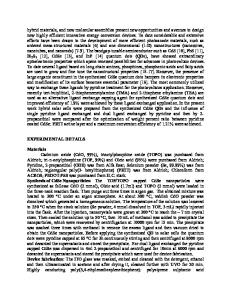Numerical Simulations for the Efficiency Improvement of Hybrid Dye-microcrystalline Silicon pin-solar cells
- PDF / 352,745 Bytes
- 6 Pages / 432 x 648 pts Page_size
- 89 Downloads / 333 Views
Numerical Simulations for the Efficiency Improvement of Hybrid Dye-microcrystalline Silicon pin-solar cells Sven Burdorf, Gottfried H. Bauer and Rudolf Brüggemann Institute of Physics, Carl von Ossietzky University Oldenburg, Carl-von-Ossietzky Str. 9-11, D-26129 Oldenburg, Germany. ABSTRACT In hybrid solar cells consisting of dye sensitizers incorporated in the i-layer of a microcrystalline silicon (μc-Si:H) pin solar cell the dye sensitizer molecules are embedded in the matrix and enhance the overall absorption of the dye-matrix system due to their high absorption coefficient in the spectral range interesting for photovoltaic applications. This contribution investigates the efficiency improvement of hybrid dye-μc-Si:H solar cells compared to pure μcSi:H solar cells by simulation. The results indicate that, under optimum conditions, the efficiency can be improved by more than a factor of 1.2 compared to a pure μc-Si:H cell. The thickness reduction for the hybrid system can be as large as 50 % for the same efficiency. However, the efficiency improvement also depends on the amount of additionally induced defects in the matrix by the embedded dye molecules. Therefore, the simulations investigate the performance of the hybrid solar cell for different absorption enhancements and defect densities. INTRODUCTION The absorption of photons is one of the key features of every solar cell. While thin-film solar cells have benefits in processing speed, material costs and carrier collection the feature of photon absorption is hindered by the film thickness. To overcome this drawback many approaches have been proposed e.g. enhanced path length of the radiation inside the active layer of a solar cell by light trapping. Another approach is to directly increase artificially the absorption coefficient of the active layer as recently Mayer et al. proposed with a hybrid structure of μc-Si:H with embedded dye molecules as sensitizers [1,2]. Organic dyes show the advantage of high absorbance but this feature is derogated by poor charge transport properties. Therefore excited states in the dye can hardly be extracted in terms of free carriers. Microcrystalline silicon on the other hand has acceptable charge transport properties while the absorption properties, especially in the low energy regime, are rather poor. The combination of these two options is therefore desirable to benefit from the high absorption of the dye molecules as well as from the transport properties of μc-Si:H. The concept of a hybrid dye-μc-Si:H absorber layer is sketched in figure 1. After the absorption of a photon by a dye molecule an exciton is created. In a second step the electron is transferred from the lowest unoccupied molecular orbital (LUMO) to the conduction band (CB) of the μc-Si:H with the rate constant ket and the hole from the highest occupied molecular orbital (HOMO) to the valence band (VB) of the μc-Si:H with the rate constant kht. For high rate constants it is inevitable that the conditions ELUMO > EC and EHOMO < EV are fulfilled, where EC and EV are
Data Loading...








